Sarah GARDINER (ROBERTS) (1813-1892)
Family Stories > 5th GENERATION
Sarah Roberts Gardiner (1813 - 1892)
Spouse : George William Launder (1811 - 1855)
1. Nola Irene Warren
2. .... George Ernest Edward Warren & Iris Ella Ford
3. .... .... Leonard Leslie Warren & Burdett Launder
4. .... .... .... Roberts Launder & Mary Burdett Salisbury
5. .... .... .... .... George William Launder & Sarah Gardiner (Roberts)
SARAH GARDINER (Sarah later changed her surname to 'Roberts' ) Birth 1813 at Brasted, Kent, UK Baptism 1813, November 28, Brasted, Kent, UK Spouse George William Launder Residences 1834-1855 As for George William Launder 1857-1861 Kent, UK 1877-1881 Oxley Road, Hawthorn 1892 2 Burwood Road, Hawthorn Occupation 1833-1851 Family carer 1851-1862 Pioneer 1855-1857 Licensee of Fletcher’s Hotel, Hawthorn 1863 Property owner and landlord, various houses, shops, stables, tents Death 1892, November 3 at Canterbury Street, Moonee Ponds Cause of Death Bronchitis and exhaustion Age at Death 79 years Burial 1892, November, Melbourne General Cemetery Once Sarah was in Australia, she took her father's surname - Roberts - as her own, in place of her baptismal name - Gardiner - her mother's name Children 1 Eleanor Ann Launder (1834 – 1923) 2 William Launder (1836 – 1890) 3 George Launder (1838 – 1914) 4 Sarah Launder (1840 – 1925) 5 Thomas Howard Launder (1842 – 1917) 6 Amy Launder (1844 – 1922) 7 Jane Launder (1846 – 1925) 8 Roberts Launder (1848 – 1910) 9 Harold James Launder (1852 – 1904) 10 Mary Ann Launder (1853 – 1943) 11 Unnamed Female Launder (1855 – 1855) |
Sarah Gardiner was 20 years of age when she married her husband, George Launder in 1834. She gave birth to and raised eight children in England. Then after receiving her inheritance from her natural father’s will in 1847, her husband, George Launder left his family to scout out the new land of Australia. He left England in 1849 and two years later in 1851, Sarah followed, travelling with her eight children on the long and dangerous voyage to the other side of the world.
In Australia, a raw, new, and relatively untamed country, she worked side by side with her husband, also giving birth to another three children.
That she raised 10 out of her 11 babies to adulthood is a remarkable feat in itself for the times in which she lived. She must have been quite a strong, capable, and resilient woman with ample common sense.
Shortly after the death of her husband 1855, she lost her last baby but unlike other women, she did not fade from history. At 42 years of age, she took over the licence of her husband’s hotel, which she later sold to finance a long holiday back in Kent. However, although George’s last will and testament left everything to his wife for her lifetime and at her death his estate to be divided between his children, the very ugly business that afterwards occurred with the subdivision and sale of the Launder land in Hawthorn was likely formulated by some of Sarah’s children as they became impatient to get their hands on their share of the property.
As with most family disputes involving distribution of wealth, it seems that most of the siblings lost in the end, except perhaps the three eldest. It must have saddened Sarah deeply to witness her children squabbling over the spoils of George and her hardships and the privations they had endured in order to establish themselves in their new country.
Sarah Gardiner – Her Early Years
1813 - Birth
In 1813, a young unmarried woman named Sarah Gardiner, living in Sevenoaks, Kent, became pregnant with a child by a man called William Roberts who was a well-to-do gentleman resident of Sevenoaks. It is also possible he may have been a member of the clergy. William Roberts owned quite a bit of land and property in Kent as well as shares and cash and employed a number of servants, quite possibly including young Sarah. Whether he looked after the young mother-to-be during her pregnancy is not known, but the young woman went to a near-by village, Brasted, to give birth to her baby.The unmarried mother, Sarah Gardiner, gave birth to a daughter on November 25 in 1813 and the little girl was christened three days later on November 28. She was given the same name as her mother – Sarah Gardiner.
The entry in the church baptismal records, which I have obtained are faint and therefore difficult to copy but shows the birth labelled as “B.B.” which means “Base Born” or born to an unmarried mother.
Whether it was courage, defiance, anger, resentment, pride or some other motivation, the young unmarried mother entered the surname of the father of her baby as “Roberts”. Her usual place of abode was Sevenoaks. William Roberts was about 47 years old at the time of Sarah’s birth. Perhaps the young mother, Sarah Gardiner, had been a servant in the house of William Roberts, a gentleman resident in High Street, Sevenoaks. We can only guess at what happened to the young mother either before the birth or after.Transcription of Parish Register of Brasted, Kent, 1813Parents’ Usual PlaceDate Child’s Name Given Names Surname of ResidenceNov 28th Sarah Roberts ………BB daughter of Sarah Gardiner Sevenoaks
Name: Sarah Roberts GardnerGender: FemaleBaptism Date: 28 Nov 1813Baptism Place: Brasted, Kent, EnglandMother: Sarah GardnerAncestry.com. England, Select Births and Christenings, 1538-1975
Thus, with this inauspicious start to life, our ancestor entered the world – baby Sarah Gardiner. Later in Australia, Sarah would adopt the surname of her father and be known as Sarah Roberts.
Sarah grew up in Sevenoaks, and it can be assumed that she had contact with her biological father, William Roberts, because before he died, he wrote a will which acknowledged Sarah as his natural daughter and included a substantial entitlement to her. It was possibly under his influence that Sarah gained a good education – there were good schools in the area at that time.
Transcription of LWT of William Roberts
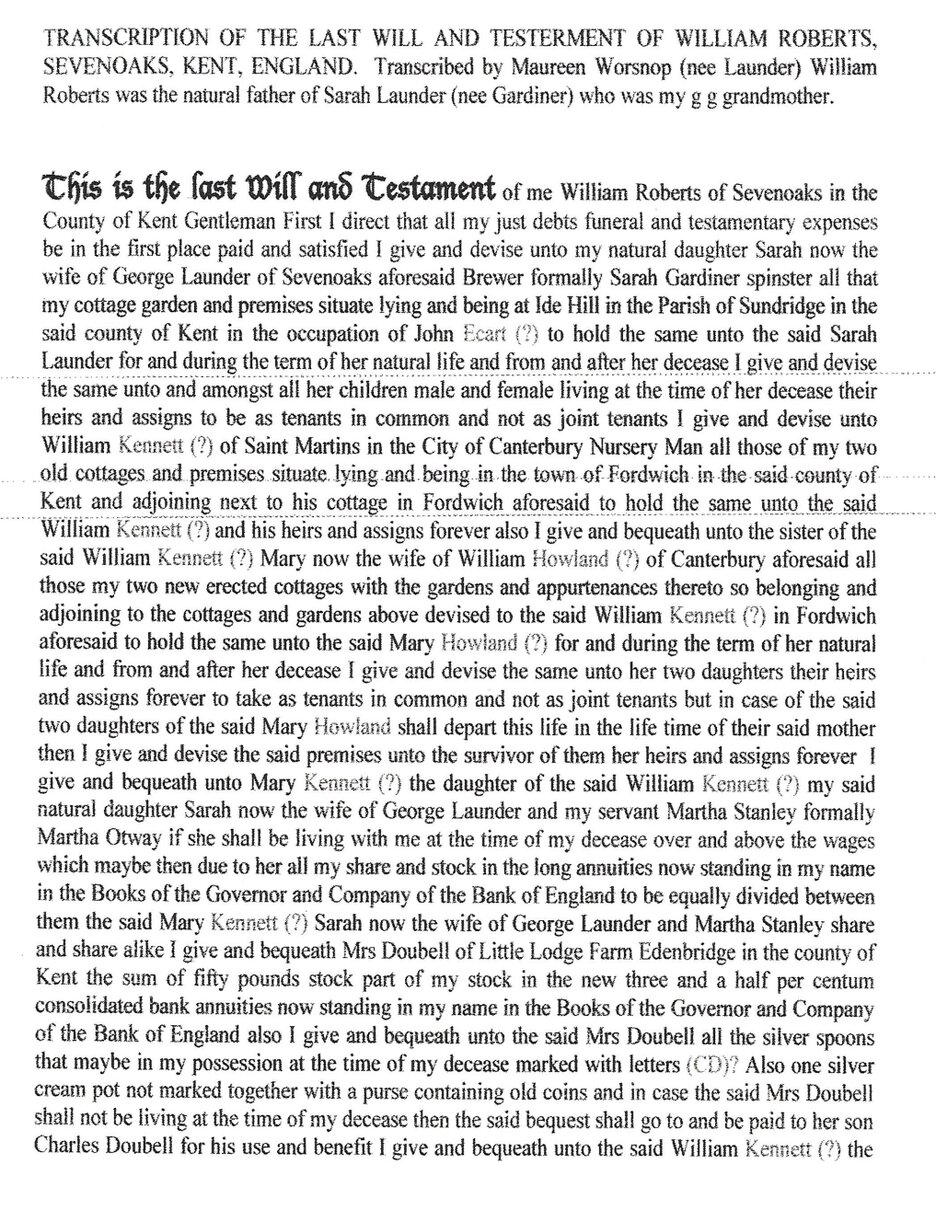
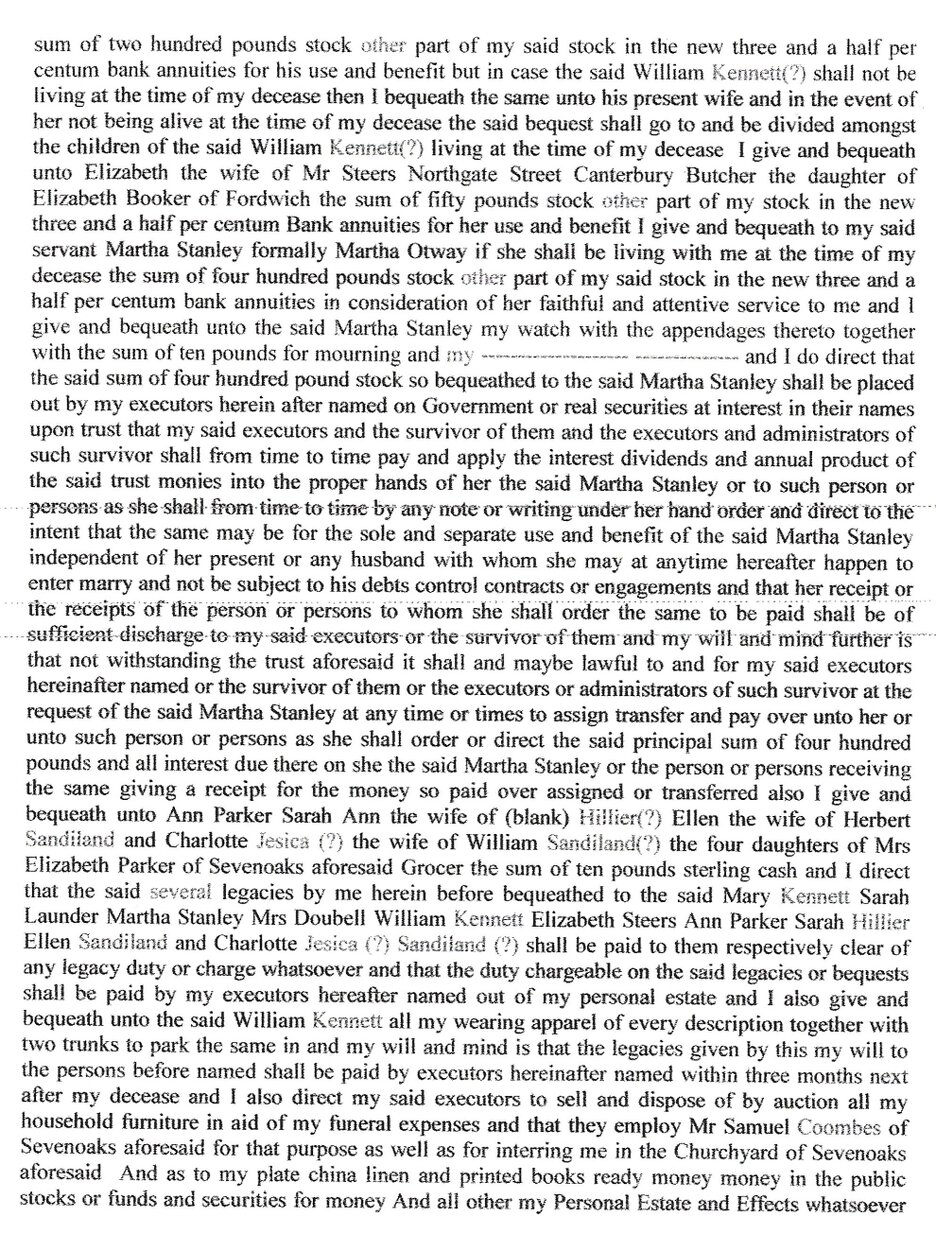
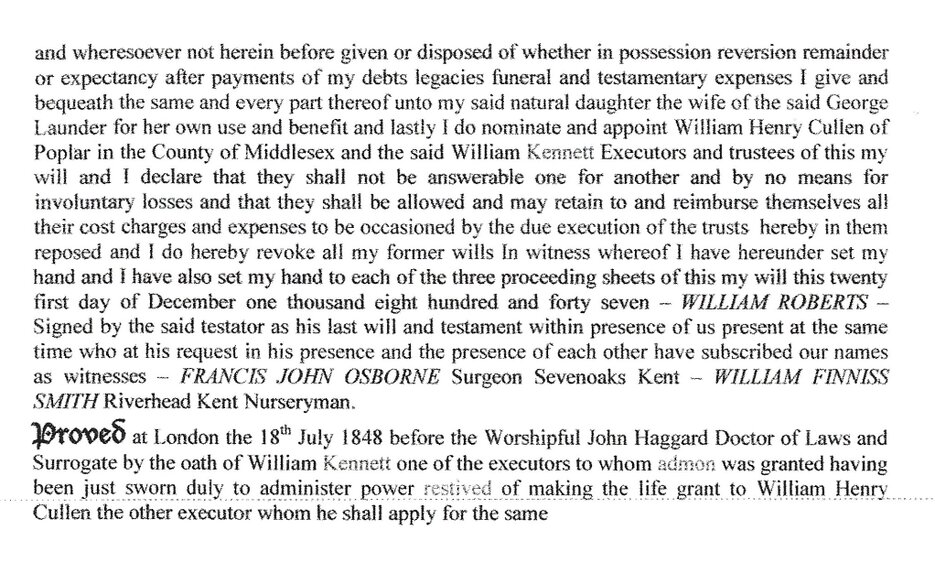
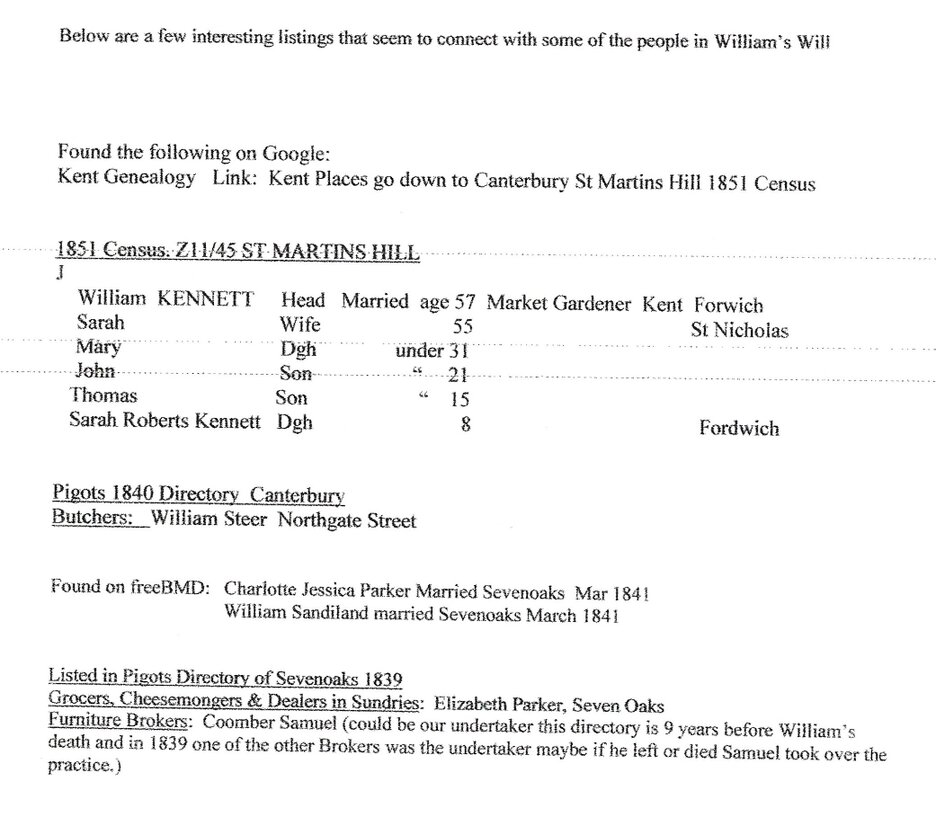
Having read the web page with the story of Sarah and George Launder's life after marriage - now read on for
Sarah's life after the death of her husband
1856 – Sarah Launder Granted Licence for Fletcher’s Hotel
Her husband of just 44 years of age dead and with ten children, the oldest of whom was 20 years, but with four children under ten years of age, Sarah was faced with life without her partner. She must have been a tough woman who took the mantle of matriarch and strode into the future undeterred.
At least she was not destitute, having a good-sized portfolio of real estate as well as cash and other assets at her disposal. One of the first things she did was to take over the running of the Fletcher’s Iron Hotel and was granted a publican’s licence on April 17, 1856. (www.coblocalhistory.phworks.com/)
1856 – Marriage, Daughter, Eleanor Ann Launder
After the usual twelve-month period of mourning, George and Sarah’s eldest daughter, Eleanor Ann Launder married John Collings on August 26, 1856 at the Albert Street Chapel in Collingwood. John Collings had worked in the Hawthorn area as a green-grocer, landlord and grocer and owned land close by Launder’s Paddock.
1857 – Sarah Launder Sells Assets
Two years after the death of her husband, Sarah decided to return to England with her younger children for a holiday and also, perhaps to finalise any real estate and financial matters she may have had there. Either to finance her trip or to rid herself of the burden of finding someone trustworthy to manage her interests in the Fletcher’s Iron Hotel, she decided to sell the hotel as well as an adjoining block of land.
Consequently, advertisements appeared in “The Argus” newspaper on January 13, 1857, the first for the hotel.
TUESDAY. 20th JANUARYImportant Sale of Suburban Freehold Property, known as FLETCHERS' HOTEL, Hawthorne.To Publicans and Capitalists.A. BLISS and CO. have been favored with instructions from Mrs. Launder, (on account of her intended departure for England,) to submit to public competition, on the premises, in the Hawthorne Road, known as Fletcher's Hotel, on Tuesday, 20th. Inst., at twelve o'clock, All that piece or parcel of Land, situate on the Hawthorne Road, at the junction of the Toorak, Gardiners' Creek, and Kew Roads, consisting of half an acre, on which is erected that elegant Iron Building known as Fletcher's Hotel.The Land on which this Hotel is built is possessed of as fine a view as any in the district and is at the junction of four most important roads for business.The Hotel is of the most ornamental description, imported for the purpose, thoroughly lined with wood and papered, large sheet glass windows, fitted up with fireplaces and stoves, and erected in the most substantial and permanent manner, and although it may appear surprising, is as cool in the interior in summer as buildings of brick or stone. It contains -Bar, Two first-class Sitting Rooms, (Opening into one with folding doors,) Bagatelle Room, Private Sitting Room, Kitchen. Scullery, and several Pantries, on the ground floor, including also, a Stone Cellar, with brick floor, capacious hall and staircase, leading to Seven large and convenient sized Bed-Rooms.The Stabling is of brick, and contains 6 stalls, and adjoining is an extra brick kitchen, and servants’ bedroom, with a very useful piece of garden ground in the rear. The whole completely fenced.This property offers a first-class inducement to invest at a large interest, and to one desirous of entering the public business is not to be equalled at this moment. The trade to the house is very good, and could be much increased by anyone accustomed to manage hotel property.The Auctioneer respectfully solicits an inspection.The furniture, fixtures, and stock could be taken at a valuation, and immediate possession given.Title Guaranteed. Terms at Sale.“The Argus” newspaper (Melbourne) Tuesday, January 13, 1857
In the same newspaper on the same day, the advertisement for the adjoining block of land -
TUESDAY, 20th JANUARYValuable Building Site in the most beautiful part of Hawthorne.ALFRED BLISS and CO. have received instructions to sell by public auction, at Fletchers Hotel, in the Hawthorne-road on Tuesday, 20th inst., at twelve o'clock (immediately after the sale of Fletcher's Hotel)All that piece or parcel of land situate in the Hawthorne-road adjoining Fletcher's Hotel, containing -100 feet frontage to the Hawthorne-road by 198 foot to a right of way 18 foot wide.This allotment is very suitable for the erection of a private residence, being on an elevation, and commanding a magnificent view of the surrounding country.
Title perfect, Terms-Cash, Sales by Auction.
Following the successful sale of the Fletcher’s Hotel, Sarah Launder withdrew her application to the County of Bourke Licensing Session on April 21, 1857, having no further need of it.
1857 – Marriage, Daughter, Sarah Launder
Sarah’s fourth-born child and her second daughter, Sarah, at just 17 years old, married William Smith at the Christ Church in Hawthorn in June of 1857.
1857 - Sarah Launder Returns to England
Thus financed, and with two of her daughters married, Sarah and her five youngest children – Amy 11 years, Henry (Harold) 5 years, Jane 9 years, Roberts, 7 years and Mary Ann 3 years – boarded the sailing ship “Essex” in September of 1857 and returned to England. It is unfortunate that during the time that Sarah was in England – and we know she returned to Kent – there were no censuses taken, and she returned to Australia just prior to the 1861 Census. So, I cannot find any information about her time in Kent, but assume she caught up with family and tidied up any loose ends of her financial affairs.
We do know that Sarah’s daughter, Amy, met George Wells from Brasted, Kent during this time, for she was to return later to marry him.
1861 – Sarah Launder Returns to Hawthorn
After about three years in England, Sarah and her children returned to Australia on board the ship “Norfolk”, leaving England in February of 1861. On her return she again settled back to life in Hawthorn, continuing to rent tents to travellers passing through to the Victorian gold fields. According to the 1863 Hawthorn rate-books, Sarah owned the following properties –
· a tent in Burwood Road, Hawthorn, rented to William James (Net Annual Value £3)
· a tent in Burwood Road, Hawthorn, rented to John Korner (Net Annual Value £3)
· a house in Burwood Road, Hawthorn, of 3 rooms and shop with 8 acres of land rented to John Bellett (Net Annual Value £40)
· a house of 3 rooms in Burwood Road, Hawthorn, rented to John Collings(Net Annual Value £12)
· a house of 2 rooms and stable in Burwood Road, Hawthorn,rented to Henry Hall (valuation £8)
· a house of 2 rooms in Oxley Road, Hawthorn, occupied by Sarah Launder (valuation £12)
Sarah lived in her house in Oxley Road, Hawthorn.
1863 – 1874 – Weddings
By 1863, Sarah was listed as owner to these properties -
- 163 - 164 Glenferrie Road, Hawthorn
- 169 - 172 Burwood Road, Hawthorn
- 166 Glenferrie Road, Hawthorn
In 1864 she had added 174 Burwood Road, Hawthorn.
Sarah’s sons, William Launder and George Launder had both travelled north to Queensland to seek their fortunes after having spent some time on the goldfields of Victoria. They both married in Queensland – William to Ellen Farmer in 1863 and George to Jane Walker in 1864.
In 1865, Sarah’s daughter, Amy, now aged 18 years and who had met George Wells during her time back in Kent in 1857 – 1861, returned to England to marry George in 1866 in Kent.
Another of Sarah’s children, Thomas Howard, married Emily Wood in September of 1866 in Geelong. It is therefore possible that until this time, Sarah had not been able to attend most of her children’s weddings, except perhaps, Eleanor Ann in East Melbourne and Sarah in Hawthorn.
Then in 1865, Jane Launder tied the knot with David Douglas in Collingwood, Roberts Launder with Mary Burdett Salisbury in 1871 in Richmond, and Harold James Launder with Georgianna Barnes in 1874 in Hawthorn.
All Sarah’s children were now married, with the exception of her youngest daughter, Mary Ann.
1876 – Sarah Launders Relinquishes her Life Share in Launder Estate
The Sands & McDougall Directory of 1875 showed Mrs. Sarah Launder was living on the south side of Burwood Road and her occupation was milliner and dressmaker. Living in adjoining cottages were her son, Roberts whose worked as a painter, her youngest daughter, Mary Ann who was also a milliner, and George, her son whose description was contractor.
Sarah, now 63 years old, and having worked hard for most of those years, still held her life share in her husband’s estate. All through this period, Hawthorn continued to thrive and grow and those who had purchased land at agricultural prices in the early days prospered as they sold at residential prices. As George had purchased the Launder Paddock land over twenty years ago at one of the earliest subdivisions, by 1876, the Launder land had increased in value many times over as residential building blocks were in high demand.
Sarah was probably too old and too tired to want to start a new venture in subdivision and some of her children were chafing at the bit to realise their inheritance that was effectively tied up until their mother’s death. It is likely that John Collings (married to Sarah’s oldest daughter, Eleanor) and Sarah’s oldest son, George Launder Jnr., saw an opportunity for financial benefit for themselves. John Collings had already dabbled in real estate investment quite successfully and George Launder, Sarah’s son, now 38 years old, seems to have been quite an entrepreneur trying his luck and ingenuity at several business ventures already. Whatever the case, moves were made in 1876 to wrest George Launder’s assets away from wife Sarah Launder in order to free up financial opportunities.
On June 12, 1876, Sarah signed over to her son-in-law, John Collings, her life estate as left to her in her husband’s will, in return for which she was promised the sum of £500. This was a paltry amount to promise to give to Sarah in return for, in effect, the management of her entire real estate and financial assets.
The very next day, June 13, 1876, the shares in George Launder’s estate for three of his children, Amy (now Amy Wells who was in England), William and George Launder Jnr., were also vested in John Collings. Furthermore, all beneficiaries to the will (George Launder’s children) joined in conveying the land at Hawthorn to John Collings upon trust, for sale.
The agreement was that after the sale, the proceeds less costs and expenses, were to be distributed to the beneficiaries.
1877 – Launder Paddock Prepared for Auction
George Launder Jnr. now a qualified surveyor, drew up the plans for the subdivision of the Launder Paddock and in 1877, the land in Hawthorn bounded by Burwood Road and Oxley Road was advertised for sale. The land had been divided into 46 separate building allotments, each of which was available for sale.
Sarah Launder occupied Lot 14 on the corner of Oxley Road.
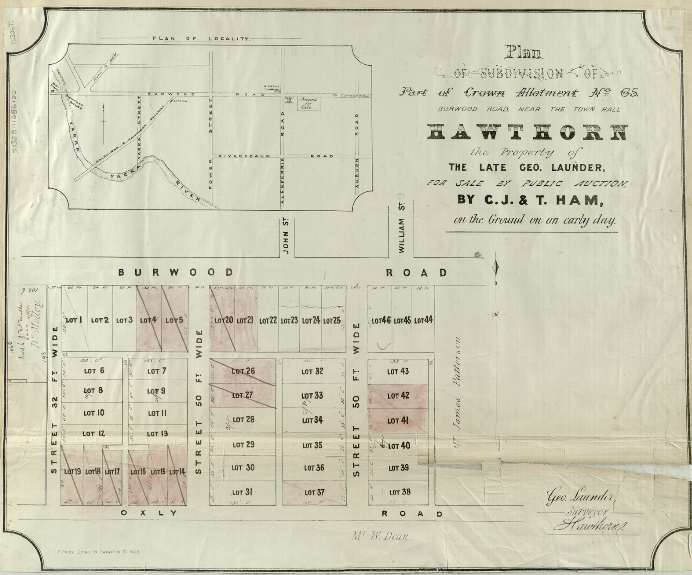
Just prior to the sale of the building allotments of Launder’s Paddock, Mary Ann Launder, the youngest sibling, took court action against John Collings for his handling of the estate sale and distribution of the proceeds of the sale. Her action took place at the same time as the sale of the allotments went ahead and was not completed until after the 1880’s.
On Saturday, February 17, 1877, an advertisement appeared in “The Argus” newspaper -
The auctioneers, C.J. & T. Ham, were relatives of John Collings, son-in-law to Sarah.THIS DAY, SATURDAY, FEBRUARY 17 At Three O'clock On the GroundTo Speculators, Investors, Gentleman In Search of Suburban Villa Sites, Storekeepers, and Others BURWOOD, OXLEY, and other ROADSBUSINESS and VILLA SITESC.J. and T. HAM have been favoured with instructions from John Collings, Esq, to SELL by PUBLIC AUCTION, on Saturday, 17th February, at three o'clock on the ground,The property of the late Geo. Launder, Esq., and known asLAUNDER'S PADDOCK,Being that magnificent block of land just above the HAWTHORN TOWN HALL,Adjoining the residences of the Right Worshipful, the Mayor of Melbourne, Sir Charles Gavan Duffy, and Dr. MolloyThis valuable property is the PICK of HAWTHORNAnd for many years intending residents have anxiously inquired when this property would be sold. It is now offered to the public subdivided Into 40 VILLAS and BUSINESS SITESEach having a frontage of about 50ft., with a depth varying from 150 ft. to 135 ft. Great care has been exercised in laying out the estate, so as to secure good rights of way and excellent drainage to each allotment.The auctioneers would respectfully Invite Intending purchasers to inspect these really choice business and villa sites, without exception the most valuable yet offered to the public, feeling assured that a personal inspection will more than fully realise their expectation.Plans of subdivision can be obtained on application to Mr. Collings, N.M.U. store, Burwood-road, Hawthorn, or at the rooms of the auctioneers.For particulars of title, being Crown certificate under Real Property Act, application con be made to Mr. J. G. Duffett, Collins Street west
The six blocks fronting Oxley Road, including that occupied by Sarah Launder were all retained by the Launder family. Sarah lived in that property from 1877 until about 1881.
Sarah was yet to receive anything of the £500 that John Collings had agreed to pay to her in 1876, so on April 22 in 1877, a deed was drawn up between John Collings and the beneficiaries to the estate to pay to Sarah 30/- (thirty shillings) per week during her lifetime in lieu of the £500 previously promised to her. The deal for poor Sarah seems to get worse!
1876 – Action by Mary Ann Launder re Sale of Launder Estate
Sarah Launder had already proven herself to be an astute businesswoman in her earlier years, so even though she was ageing, she may have been unhappy with the treatment she had received at the hands of her family and son-in-law, John Collings. Perhaps she had been bullied or rushed into signing the agreements turning over her estate in return for £500 and then for 30/- per week. Or perhaps her youngest daughter, Mary Ann, now aged 23 years old, realised what was happening to her mother and saw the deals for what they were – a means of stealing her mother’s fortune.
Whatever the reason, Sarah’ daughter, Mary Ann, was her sole supporter and it was therefore Mary Ann who she relied on to carry her grievances to court. None of her siblings appears to have helped her in any way even when it could have meant a redistribution of monies accrued from the sale of the Launder properties. Why? Or rather, why not?
I believe it was a combination of greed, ignorance, and unfounded trust. Eleanor, married to John Collings, stood to gain from any financial trickery. William was living in Queensland and probably relied on his brother George Jnr. for guidance and advice. George Jnr. was most likely very much involved in the whole business as he had already shown a flair for wheeling and dealing and was very much involved in the business of relieving his mother of her assets, having been the surveyor who put together the subdivision plans.
As for the rest of the children, Sarah, Amy, Jane, Thomas and Roberts – they may have been dazzled by the promise of easy money and put their trust in their older brother George, and their brother-in-law, John Collings to take care of the details and to do the right thing.
Or perhaps many of the siblings were involved in or had knowledge of the tricky business going on and did not want details aired. Or perhaps it was just a simple case that some of them did not understand what was happening. They had been provided by John Collings with some money and that was all they cared about.
Consequently, Sarah’s daughter, Mary Ann Launder, also one of the estate’s beneficiaries, brought an action demanding the execution of the trust of June 13, 1876 – that is the distribution of the proceeds of the sale of the Launder land to the beneficiaries to the will. She also wished for the purchase by John Collings of Lot No. 1 to be set aside on the grounds that a trustee for a sale could not purchase from himself.
The court heard that after the execution of the deed dated June 13, 1876, the land at Hawthorn was surveyed and subdivided into lots for sale. Several sales were made and from time to time the beneficiaries had meetings at which statements of accounts were submitted to them by John Collings.
Some of the proceeds were held back by Collings and apparently invested by him to provide a fund for the payment of the 30/- per week to Sarah Launder. And it was out of the residue of sale proceeds, that payments were made from time to time to the beneficiaries.
At each of these payments, all parties were required to sign a document which read –
We the undersigned do hereby admit to have received from John Collings of Hawthorn in the colony of Victoria, grocer, the sum of money set opposite to our respective names in the schedule hereunder written and in consideration hereof do hereby release and discharge the said John Collings of and from all actions, recoverings, claims and demands whatever, for by reason or on account of the sale by him of part of 10 acres of land being part of Crown portion 65, parish of Boroondara at Hawthorn, county of Bourke.
It seems whenever John Collings gave each of the beneficiaries some amount of money from the sale of the Launder land, he then asked them to sign away any rights to question his accounting for the sale proceeds. It is not clear whether any statement of income and disbursements were tabled by John Collings at these meetings.
On March 19, 1886, a meeting of the beneficiaries was held at which Mary Ann Launder was not present. A balance sheet was presented by John Collings showing a credit balance of £3,252/12s./5d. The sum of £408/8s./-d. was then payable to each of the beneficiaries and was paid to those present. Just how a credit balance of some three thousand, two hundred and fifty pounds was divided between ten beneficiaries with each receiving the sum of more than four hundred pounds is strange and perhaps throws light on Collings’ accounting techniques.
Anyway, shortly after this, John Collings called on Mary Ann Launder at home and offered to pay her £408/8s./-d. on condition that she sign a release document, which he produced. This release was different from those previously signed. It was a release of all accounts, claims, etc. on account of the sale of the whole of the land and also –
…… and we do hereby admit that we have no further claim whatever against the said John Collings, except as to the moneys he has invested or is to invest to secure the allowance to our mother during her lifetime.
Mary Ann Launder refused to sign the release document proffered to her by John Collings saying that she wished all the accounts relating to the sale of the Launder land be submitted to an independent audit. She clearly did not trust that John Collings had administered his duties properly and had not distributed monies from the sales fairly in accordance with the trust arrangement.
Mary Ann also repeated her objection that she had made previously regarding the purchase of Lot No. 1 by John Collings using a fictitious name.
Collings then refused to pay her the £408/8s./-d. and subsequently handed the cheque to his solicitor with instructions that the cheque was not to be given to Mary Ann until the release was signed.
Mary Ann later offered to give a simple receipt for the money, but this offer was refused by the Collings’ solicitor on instructions from John Collings.
During the court case, Collings’ counsel admitted that Mary Ann was entitled to the accounts but argued that the accounts were to be dated only from the last release signed by her. Mary Ann’s counsel countered by arguing that considering the circumstances under which the releases were from time to time signed and their indefiniteness and the fact that the accounts had never been audited in any way, that Mary Ann was entitled to have the whole accounts of the trust audited.
The court then addressed the other issue raised by Mary Ann – the sale of John Collings of Lot No. 1 to himself. The court heard that on June 9, 1882, a meeting of the family was held at which Collings produced and read a balance sheet on which appeared an item – Sale of Lot 1, Toon, £360. Mary Ann made comment about the sale saying she thought it had been sold too cheaply. Collings then said that he was Toon and he had purchased it in another name to gain title. He said he had paid £6 per foot for Lot No. 1. He said that if any present wanted to buy it back from him at that price, plus costs, he would sell it. No member accepted the offer, but it was not clear whether any of them were in a position to be able to purchase it.
At another family meeting held on March 19, 1886 at which Mary Ann Launder was not present, the purchase of Lot No. 1 was again raised but no-one present objected to the sale. Collings then wrote on the back of the final release – the question of legality of J. Collings being the purchaser of Lot 1 was mentioned, he being the trustee. We consider that the purchase was fair and just, whatever the law may be.
This was then signed by all beneficiaries, except Mary Ann who was not present at the meeting.
In court, Collings admitted that the purchase of Lot No. 1 by him could not be supported as a purchase by him from himself, but he argued that what took place at the meeting of June 9, 1882, practically amounted to the purchase by him from other members of the family and not from himself.
Judgement in the Launder V Collings Case
After due consideration, it was held that the evidence provided satisfied the case that Mary Ann Launder had not agreed to the purchase by Collings from Collings. She was therefore entitled to object to this purchase as a breach of trust by him. However, as the other beneficiaries had expressed their satisfaction with the purchase by Collings from himself, it was not necessary to order that the purchase be set aside, especially as Collings desired to retain his purchase and the other beneficiaries were not objecting.
The judgement was based on precedence in the case of McGill V Fisken wherein there was a suit by one partner to set aside a sale of partnership property at a lower price than that authorised by the plaintiff. The sale was not set aside but it was directed that payments be made to the plaintiff of the difference between the sum sold and the sum authorised. In that case, the plaintiff’s co-partners were made defendants.
The case of Launder V Collings differs from the McGill case in that the other beneficiaries were not parties to the action. Nevertheless, the judge declared that for abundant caution, the judgement shall be without prejudice to their rights, if any.
The court proceeds were lengthy and took ten years for the judgement to be handed down. It was reported in The Argus newspaper on September 23 1887 –
Mr Justice Webb gave judgment in the Supreme Court yesterday in an action of Launder v Collings the plaintiff, Mary Ann Launder, sued the defendant, John Collings, for accounts relating to the sale of certain land at Hawthorn.His Honour was of opinion that the plaintiff was entitled to have all the accounts relating to the property taken and that the defendant was liable to the plaintiff for her share of the difference between the price he paid for the allotment bought by him and its present value, and he made a decree for accounts on that basis, the defendant being allowed 6 per cent interest on the payments made by him in respect.
An interesting snippet published in “The Ancestor” magazine in June 1964 of reminiscences of a Collings descendant in which he mentions his grandmother, Eleanor Collings, nee Launder and the Launder Paddock property sale. In this article, he said –
……. Launder Paddock ……. Situated between Burwood Road and Oxley Road was sold in the 1880’s. In the subdivision of 46 lots were Kent, Launder and St. Columns Streets. The Church of England paid £1,385 for the lots on which St. Columbs Church and the Hall now stand. The total 46 lots brought in £12,940/8s./-d.
I have been unable to confirm any of the financial details relating to the subdivision or distributions to the beneficiaries, however I believe audited accounts were eventually supplied to Mary Ann, although to what effect is unclear.
Throughout the period from 1877 to 1879, Sarah lived in a cottage at 15 Oxley Road, Hawthorn, which was situated on the east corner of Launder’s Paddock.
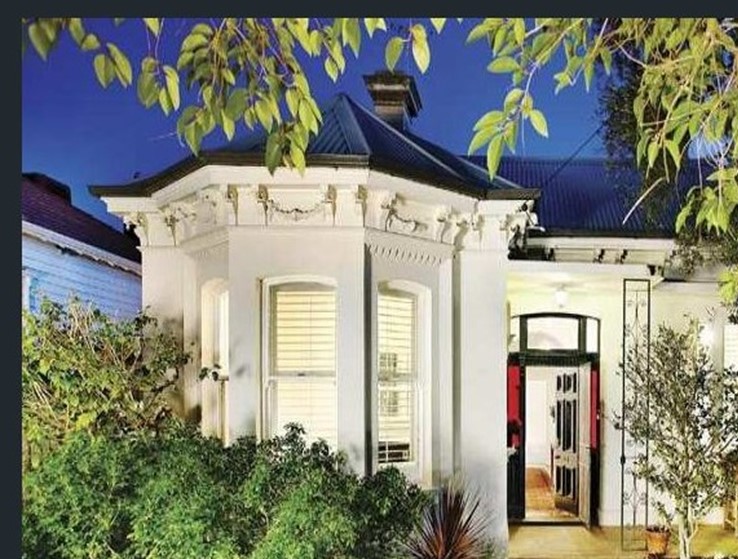
This is today’s photo of a house at 13 Oxley Road, Hawthorn, probably similar to that which Sarah inhabited.
1882 – Sarah Resides Burwood Road, Hawthorn
In 1882, Sarah was then 69 years old and she moved to another cottage at 2 Burwood Road Hawthorn. It is likely that Mary Ann still lived with her mother as she was as unmarried. Sarah’s cottage has long since been demolished as has her cottage in Oxley Road, Hawthorn.
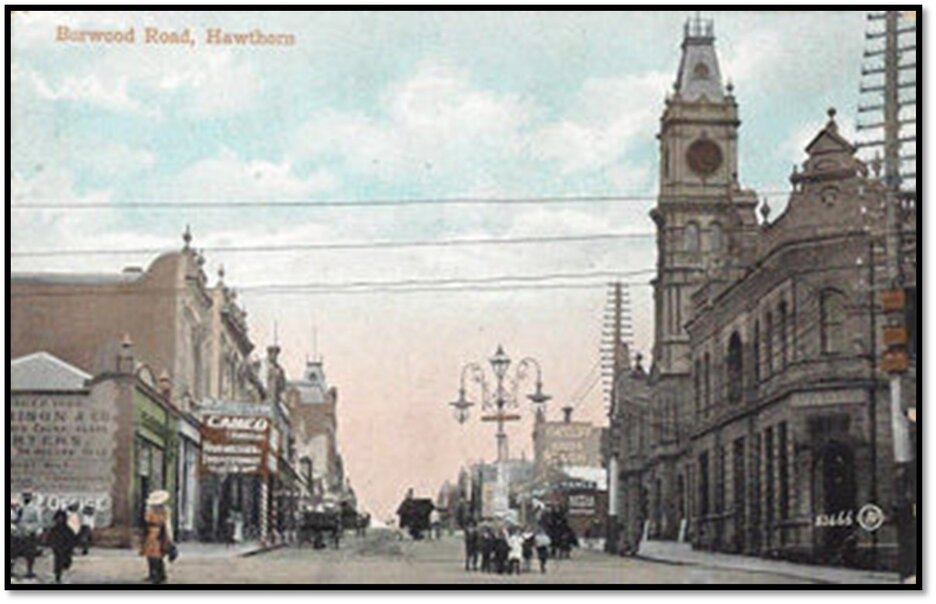
‘Postcard of Burwood Road looking westward’, c. 1910, City of Boroondara catalogue no. lhph00499.
The buildings on the right-hand side were built on land owned by George Launder.
1892 – Marriage, Daughter, Mary Ann Launder
At the relatively older age of 39 years, Sarah’s daughter, Mary Ann Launder married John Jeffries at St. Paul’s Cathedral in Melbourne on June 22 of 1892. I do hope that Sarah was well enough to see her youngest daughter marry for Sarah had just months to live before her death in November.1892 – Death of Sarah Launder
At the age of 79 years, Sarah succumbed to bronchitis which had plagued her for the last month of her life. She passed away at her daughter, Sarah Smith’s house at 16 Canterbury Street in Moonee Ponds on the 3rd day of November in 1892. Sarah had been in Australia for 42 years at the time of her death. A transcription of her death certificate reads –Deaths in the District of Bourke in the Colony of Victoria
When and where died 3rd day of November 1892, Canterbury Street, Moonee Ponds, Town of Essendon, County of Bourke
Name and Occupation Sarah Launder, Wife
Sex, Age Female, 79 years
Cause of Death Bronchitis, Exhaustion
Duration of Illness 1 month
Medical Attendant by whom Certified Dr. Dickinso
When last saw Deceased 1st November 1892
Name and Surname of Mother & Father William Roberts, Unknown, formerly Unknown
Rank or Profession Gentleman
Signature, Description & Residence of Informant Sarah Smith, Daughter, Moonee Ponds
Date and Where Registered 4th day of November, Essendon
When and Where Buried 5th day of November 1891, Melbourne General Cemetery
Where Born & How Long in Australian Colonies Kent England. Colony of Victoria 42 years
If Married, Where, Age and To Whom Kent England, 20 years, George Launder
Issue, in order of Birth, Their Names & Ages Ellen Launder, 58
William, deceased
George, 54
Sarah, 52
Thomas, 50
Amy, 48
Jane, 46
Roberts, 44
Harry, 40
Mary Ann, 38
It is sad to note that inspite of Sarah standing side-by-side with her husband in their early years in Australia, renting out tents to travellers to the gold fields, raising a large family, ensuring her children all had good educations, and then in widow-hood, running a hotel, managing many assets and properties - she was awarded the occupation of "wife". And her young mother, Sarah Gardiner, was forgotten, but not her wealthy father, William Roberts.
Sarah Launder was laid to rest two days later at the Melbourne General Cemetery and joined her husband, George.
And so, ended the lives of George and Sarah Launder, the first generation of the Launder in Australia.
